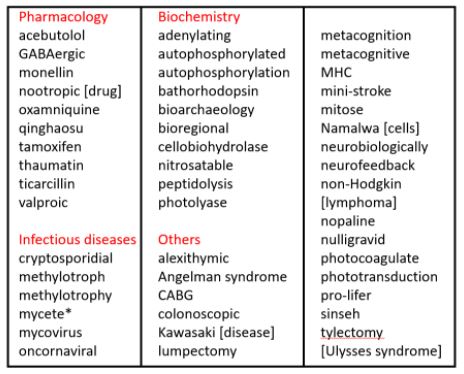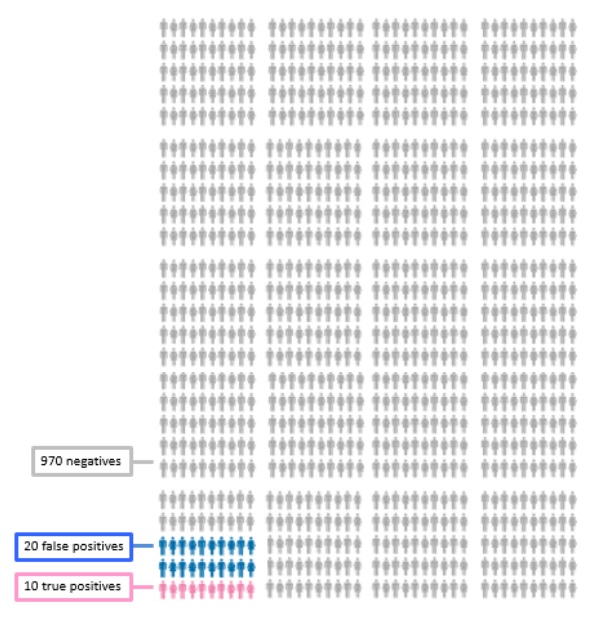Last week I listed the biomedical words whose first known written instances listed in the Oxford English Dictionary (OED) date from 1971. This week I have explored 1972 (Table 1). In 1970 and 1971 pharmacology led the way. This time biochemistry has caught up.
Table 1. Biomedical words (n=48) in the OED for which the earliest citations are from 1972 (out of a total of 338; I have added a 49th); I have found only one antedating, from 1894

*Antedating: mycete 1894
There are, however, two connected terms that I would have expected to have found in the 1971 and 1972 lists, but which have not yet made it into the dictionary.
The Greek hero Odysseus was born when Sisyphus seduced Anticleia, wife of Laertes and daughter of Autolycus, who had stolen Sisyphus’s cattle. In The Greek Myths, Robert Graves reported that Autolycus, invited by Anticleia to choose a name for the child, said, “In the course of my life I have antagonized many princes, and I shall therefore name this grandson Odysseus, meaning the Angry One, because he will be the victim of my enmities.” The Greek verb ὀδύσσομαι meant to hate or be angry. Liddell & Scott in their Greek–English Lexicon say that Odysseus was so named because he was hated by gods and men. Or perhaps the name was an expression of Autoclycus’s anger at his daughter’s seduction.
The word ὀδύσσομαι comes from the IndoEuropean root ODI, hate or disgust, as in odium. But in some cases the IndoEuropean letter D turns into an L in derivatives; for example, compare odour with olid and olfactory. So, in Latin Odysseus became Ulysses.
Recently, a systematic review of the biomedical literature via PubMed has unearthed 112 publications that refer to the myth of Odysseus or Ulysses, including the Ulysses contract, the Ulysses conflict, and three different Ulysses syndromes. Two other mythologically related syndromes also emerged, the Elpenor syndrome and the Penelope syndrome. However, other terms escaped notice, such as the Ulyxes genus of Australopapuan mites, of the family of Laelapidae. Laelaps, from λαῖλαψ a whirlwind, was one of Actaeon’s dogs, whose ferocious onslaught no beast could resist. Species of the Laelapidae have been named Ulyxes autolycus, Ulyxes euryclea., and Ulyxes theoclymenus, which have Odyssean connections. Eurycleia was Odysseus’s nurse and Theoclymenus was a prophet who sailed with Telemachus, Odysseus’s son, and foretold Odysseus’s return to Ithaca. The Odyssean connections are listed in Table 2.
Table 2. Biomedical terms involving the names of Ulysses or people connected with him
| Term | Description |
| Ulysses complex | See the text. |
| Ulysses syndrome Type 1 | A journey ending in mental and/or physical disorders following a false positive result. See the text. |
| Ulysses syndrome Type 2 | Psychopathological symptoms due to high levels of stress suffered by immigrants. |
| Ulysses syndrome Type 3 | Nihilism by proxy. The delusion that relatives are ill despite evidence to the contrary. Because of his absence Penelope believed that Odysseus was dead and continued to believe it for some time after his return, because Athena had changed his appearance. |
| Ulysses contract | An expressed desire of an individual, written or oral, about a treatment that they want or do not want to be subject to if, when the time comes, they may not be able to give consent; an advance directive or living will. When Odysseus and his men are sailing past the Sirens, he stops their ears with wax, has himself tied to the mast, and instructs them on no account to pay any attention to his pleas to be released as they pass. He is thus able to suffer their Siren song without yielding to them, and they perish as a result. |
| Ulysses arrangement or Ulysses agreement | A version of the Ulysses contract, in which someone with a psychiatric problem (e.g. anorexia nervosa) agrees in advance to a method of treatment when relapses occur. |
| Ulysses conflict | The occurrence of conflicting mental states in a single mind, leading an individual to act so as to subvert their own desire; for example, wanting to lose weight but unable to resist overeating. This also derives from the story of Odysseus and the Sirens. Although he wanted to hear their song he knew that doing so would make him act against his own interests. |
| ULYSSES study | A study of myocardial ischemia using regadenoson low-dose dynamic computed tomography myocardial perfusion in patients with intermediate coronary artery stenoses; the name of the study is not explained in either the protocol or the final report, but it appears to be based on a random selection of letters from the title: Utility of Regadenoson Low-dose Dynamic Computed Tomography for Myocardial Perfusion Assesment [sic]; regadenoson is an adenosine A2A receptor agonist. |
| Ulyxes | A genus of Australopapuan mites associated with arboreal nests; U. autolycus is named after Odysseus’s grandfather and U. euryclea after his nursemaid, Eurycleia. |
| Papilio ulysses telegonus; Papilio laertes | Species of butterfly. Telegonus was the son of Odysseus and Circe. Laertes was Odysseus’s supposed father. |
| Elpenor’s syndrome | A state of semi-consciousness with disorientation that occurs when people who awake having gone to sleep in an unusual place after having drunk too much or having taken hypnotic drugs. Elpenor was the youngest member of Odysseus’s crew; he was fatally injured when he fell off the roof of Circe’s palace, on which he was sleeping off a hangover; Odysseus met him again when he visited Tiresias in Hades. |
| The Penelope syndrome | Encephalopathy with status epilepticus during sleep, marked by a peculiar electroencephalographic pattern characterized by paroxysmal activity significantly activated during slow-wave sleep. Penelope, Odysseus’s wife, wove her tapestry during the day and unravelled it at night. |
| The Sisyphian concept | Specifically, difficulty in maintaining the doctoral degree for nurses in the USA. Likened to the difficulty that Sisyphus had in Hades when set the task of rolling a rock uphill, only to find that it has rolled down again and that the task must be repeated. This concept could be extended to the difficulty in maintaining any academic discipline that comes under threat. |
| Sisyphus manifold | One of two types of time-dependent slow manifolds, Sisyphus and Laelaps manifolds, that occur in the asymptotically autonomous vector fields that arise from enzyme-coupled reactions |
The Ulysses complex was first described in 1971. It has three aspects, related to the story of Telemachus: the absence of a father; an attempt to imagine a father replacement by the superego; and the consequent formation of imagined father–son affection, strengthening the ego. It should probably have been called the Telemachus syndrome.
The first Ulysses syndrome, described in 1972, involves a form of medicalization, which I discussed last week. In this case it starts with a false positive result in a healthy individual. This leads to other tests, the results of some of which will be either negative or falsely positive. Further investigations follow. Treatments based on presumed diagnoses then lead to harms. Rang, who first described the syndrome, gave an example. A boy falls and hurts his leg. An x-ray shows no trauma but there is an incidentaloma—an area of abnormal bone. Blood tests are negative. An orthopaedic surgeon biopsies the lesion and the pathologist diagnoses a minor fibrous cortical defect. The child falls on the slippery hospital floor and fractures his leg where the bone was weakened by the biopsy. He spends 6 weeks in plaster. Other examples have been reported (for instance, here and here).
Are we currently the victims of a form of Ulysses syndrome? Let us suppose that the point prevalence of covid-19 is 1%. Thus, of every 1000 patients tested at any time, 10 will have a true positive result. But the false positive rate of SARS-CoV-2 rt-PCR is somewhere between 0.8% and 4.0%, let’s say 2%. So, about 20 of the other 990 patients tested will have a positive result. Thus, of 30 positive tests only one-third indicate true infection (Figure 1). The higher the prevalence the better the ratio becomes, but even at a 2% prevalence half of all positive tests will be in people without the infection. Others have discussed this problem, which is not new, but generally ignored. To calculate the true rate of infection among those with positive tests we need to know both the prevalence and the false positive rate, but that information is never given in media reports. Without it, how can we interpret reportedly positive test results?
Figure 1. With a 1% prevalence of the infection, 10 out of 1000 people will test positive, having the infection (pink); with a 2% false positive rate, 20 will test positive, not having the infection (blue); i.e. only one-third of those with positive tests are actually infected; this analysis ignores the few false negative tests that will occur in those with the infection, reducing the number of true positives even further
Jeffrey Aronson is a clinical pharmacologist, working in the Centre for Evidence Based Medicine in Oxford’s Nuffield Department of Primary Care Health Sciences. He is also president emeritus of the British Pharmacological Society.
Competing interests: None declared.


